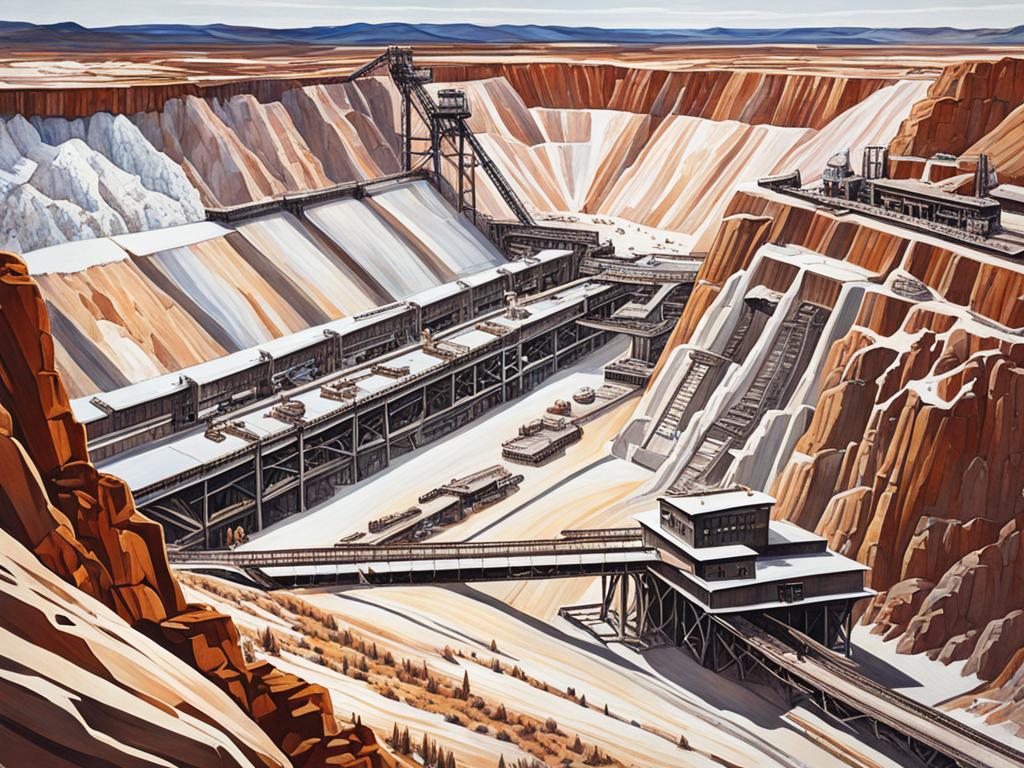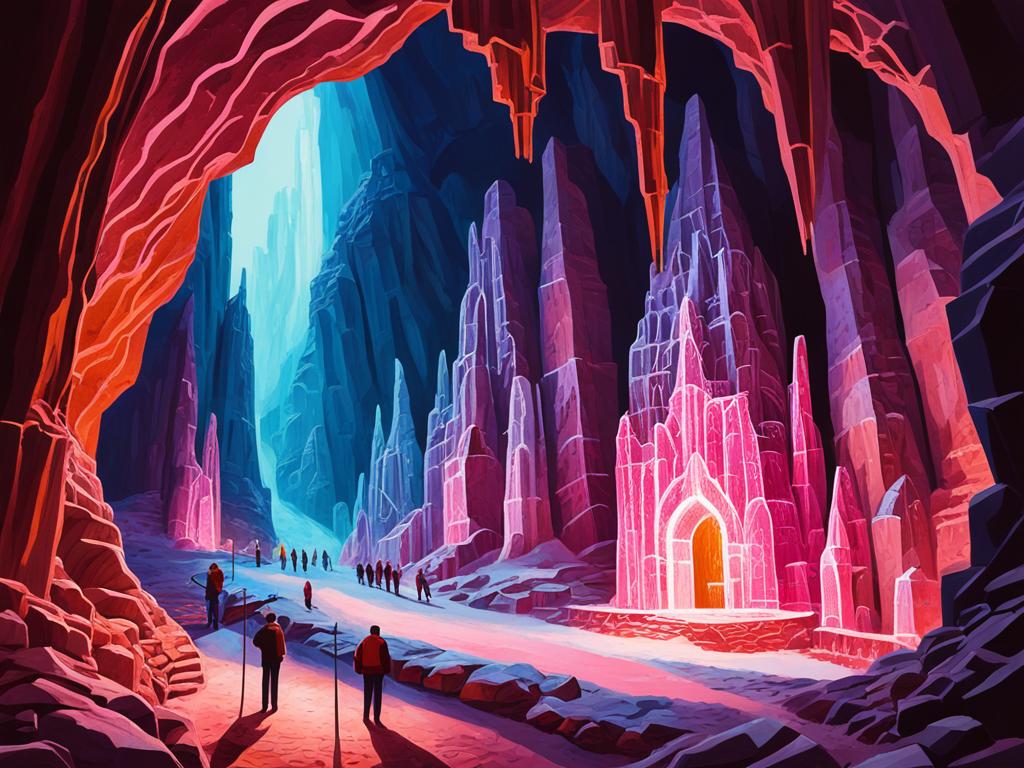Imagine walking into a vast underground world. The air smells of salt, and walls shine like art. Salt has been important for centuries, moving from a rare item to a key part of our diet. We’re going to look at the biggest salt mines in the world. These places show us the history of salt mining and the beauty of nature.
From the Sifto Salt Mine in Canada, under Lake Huron, to the Atacama Salt Flat in Chile, each place is special. They show us the beauty of nature and human skill. Let’s explore these salt mines together, seeing what makes them important.
The Sifto Salt Mine in Canada
The Sifto Salt Mine is under Lake Huron in Goderich, Ontario. It’s the biggest salt mine in the world. Sam Platt found it in 1866 while drilling for oil. Now, it makes about 7,250,000 tons of salt every year.
It has around 800 workers. The mine gives jobs to 600 people directly. It also helps many others with its plants in Goderich, Unity, and Amherst.
This mine can keep making salt for 120 more years. It has made about 150 million tonnes of salt so far. It’s key for keeping roads clear in winter, showing its big economic role.
Khewra Salt Mines in Pakistan
The Khewra Salt Mines are the second biggest salt mine in the world. They have a long history, starting in 326 BC. It’s said Alexander the Great’s horse found the mine.
Every year, they make over 370,000 tonnes of Himalayan salt. They have huge reserves of 220 million tonnes over 110 square kilometres.
The mine has tunnels over 40 kilometres long into the mountains. It goes down about 730 metres. The temperature is always 18–20 degrees Celsius.
There are 17 working levels, with five underground. This makes it a special place for mining and tourism.
The mines are important for culture and the economy. They make things like lamps, vases, and cooking salt. These items go all over the world.
Every year, about 250,000 people visit the mine. It’s a big tourist spot. The Khewra Salt Mines Railway helps move salt out of the mine.
| Attribute | Details |
|---|---|
| Annual Production | 370,000 tonnes |
| Estimated Reserves | 220 million tonnes |
| Tunnel Length | 40 kilometres |
| Area Covered | 110 square kilometres |
| Tourism | 250,000 visitors annually |
| Temperature | 18–20 degrees Celsius |
| Purity of Salt | 96%, reaching up to 99% in some areas |
The Khewra Salt Mines are key to Pakistan’s economy and history. They show a long history of salt mining that draws people from all over the world.
Salt Mines in the World: Slanic Prahova Salt Mine in Romania
The Slanic Prahova Salt Mine is in Slanic, Prahova County, Romania. It’s the biggest salt mine in Europe. People come from all over to see it. It’s near Bucharest, 100 km north.
This mine is open for visitors. It shows off beautiful underground places and salt shapes. It’s a mix of nature and history.
The Unirea salt mine started in 1938. It was a big part of salt production until 1970. It’s huge, with 78,000 m² and 14 big chambers. The mine is filled with salt, with a special climate that’s good for your health.
There’s a deep mine that goes 208 meters down. It has sports courts and places for kids to play. There’s also a museum with salt art and statues of famous people.
This mine is great for people who want to be healthy. Or just for fun. It has lots to see and do.
| Feature | Details |
|---|---|
| Location | Slanic, Prahova County, Romania |
| Depth | 208 meters |
| Chambers | 14 trapezoidal chambers |
| Total Area | 78,000 m² |
| Volume | 2.9 million m³ |
| Temperature | 12°C |
| Humidity | 10% lower than the surface |
| Sanatorium Capacity | 50 places |
| Tour Duration | 2 hours |
Wieliczka Salt Mine in Poland
The Wieliczka Salt Mine is a UNESCO World Heritage Site near Krakow, Poland. It has been working since the 13th century. It’s one of the oldest mines in the world. Every year, over 1.2 million people visit it, going down 327 metres (1,073 feet) into the mine.
Inside, you can see amazing salt sculptures and carvings. The Chapel of St. Kinga is a big highlight. It’s made entirely of salt. People love the craftsmanship in the mine, each chamber has its own story.
The mine covers a huge area of 970 hectares (2,400 acres). It has a special area for conservation too. Famous people like Nicolaus Copernicus and Pope John Paul II have visited this place.
- Over 1.2 million visitors annually explore the mine
- Features four chapels and numerous salt sculptures
- Contains an underground lake
During World War II, the mine was used for making things underground by German forces. It stopped making salt in 1996. But, it’s still a big deal because of its history and culture.
The Tourist Route is 2.2 kilometres long and shows the best parts. There’s also a Museum Route that tells about salt making history. The mine shows how society and technology changed over time.
Going to the Wieliczka Salt Mine is a way to say thanks to the salt makers. It’s best to stay in Kraków for two days to see the mine and more of the area’s culture.
Atacama Salt Flat in Chile
The Atacama Salt Flat, also known as the Salar de Atacama, covers over 3,000 square kilometres. It’s the largest salt flat in Chile. It sits in the Atacama Desert, one of the driest places on Earth, surrounded by the Andes mountains.
This salt flat is not just beautiful. It’s also key for the global lithium market. It has about 27% of the world’s lithium and makes 36% of the lithium carbonate supply as of 2017.
Lithium mining has grown here because of the need for lithium-ion batteries. These batteries power things like smartphones and electric vehicles. Companies like Sociedad Química y Minera (SQM) and Albemarle lead in this field.
The process to get lithium involves pumping brine into large ponds. Here, the sun evaporates the water, leaving behind concentrated lithium. This takes 12 to 18 months.
The salt flat is also important to the Likan Antay people. They have been talking about how lithium mining affects their land. The Atacama Salt Flat shows how natural resources and sustainability can work together. It brings both chances and challenges for the future.

